The genesis of the Tiger's distinctive turret was in February 1941, when it was decided that Germany needed a tank with a large gun. The "Panzer commission", a consultancy headed by Porsche, had been working on a new tank, the "Type 100", in early 1940. Now the project was revived.
Krupp was part of the consortium, and they outlined a new turret by March. The following are extracts from a drawing of the "Type 100" :
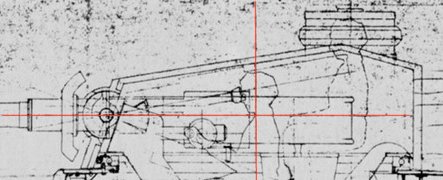
This conceptual design can be considered the ancestor of the Tiger's turret, and it has some features that carried through into the Tiger: the commander is placed to the left of the gun and there is an external mantlet. Three possible guns were being considered at this stage; this drawing shows an 88mm gun.
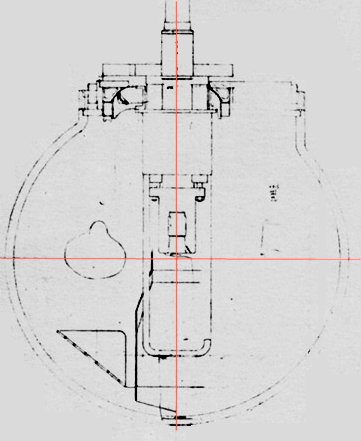
This plan view of the same turret concept is badly faded, but we can see more features that ended up in the Tiger's turret: the gun is on the center line and the turret is asymmetric. The sides and rear are a single plate formed into a cylinder.
The 88mm L/56 gun was selected in April and Krupp got a contract to build six turrets. Meanwhlle they were reworking their turret design. They decided to make its armour wall in a "U" shape, circular at the rear but flat at the front. They simplified the roof by making it a single flat plate with a gentle slant of 2.25 degrees.
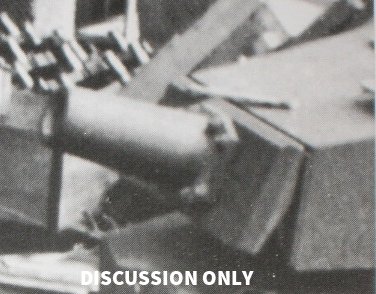
We don't have detailed drawings of this refined 1941 turret design, but we do have some images. In this factory photograph we can glimpse a wooden mockup of the turret, made around this time. It now has a full-width mantlet with a tapered gun sleeve.
We also have some sketches. A year later, when the designers were laying out the Tiger's hull, they drew a turret outline into a hull drawing. Although it's not precise or fully detailed, we can see that it doesn't match the turrets already being constructed in 1942, so they must have copied an old 1941 drawing that is now lost.
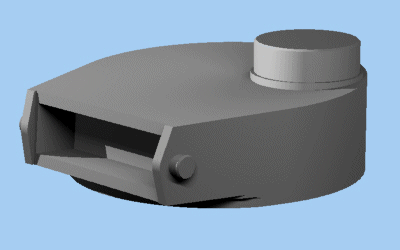
They sketched only the main armour plates, gun and cupola. This is a model of what they drew. It's obviously a close relative of the production Tiger turret, with the front edge in particular having the same profile. The cupola was sketched as a cylinder so it's not clear if the intent was to clad it in movable armour shields, as in the older "Type 100" drawing.
After this, Krupp continued to refine the design. They made the turret asymmetric, with more internal space on the gunner's side. They made the gun sleeve cylindrical. Meanwhile, the "Type 100" tank project had been superceded by the "Type 101" and the turret was assigned to that.
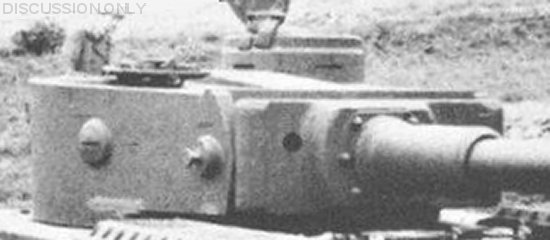
Krupp eventually built a batch of eight turrets for the "Type 101". This photo shows one of them. Its external features such as pistol ports and cupola appear to be essentially the same ones that will end up in the Tiger (H). If there was ever a plan to put movable shields on the cupola, they have now been eliminated because with this thickness of armour they would be unwieldy.
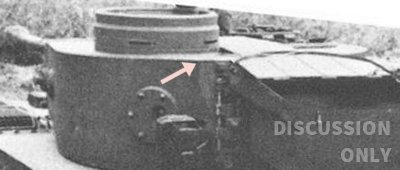
This turret has the 2.25 degree roof from the 1941 design, but there is now a raised longitudinal segment in the middle. As this photo shows, it runs all the way to the back wall.
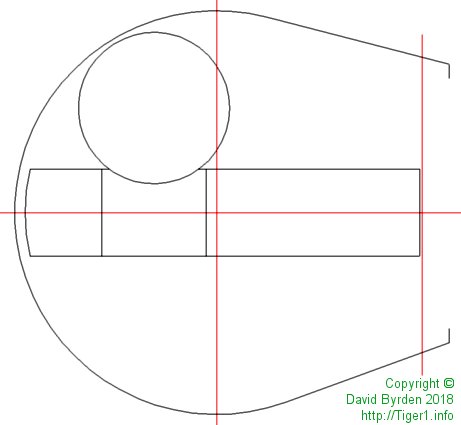
This plan view reveals that the raised segment intersects with the cupola, adding to the complexity of this roof.
The raised segment was apparently added to correct a mistake. A travel lock was designed for the gun, to be placed above it, but it would not fit between the gun and the original one-part roof. A creative thinker might have decided to lock the gun at an angle, making more room, but Krupp's designers preferred to lock it in the traditional horizontal position. They raised the roof instead.
I believe that the armour walls for these eight turrets had already been cut, so Krupp were obliged to raise only the middle segment of the roof. Meanwhile a redesign could be carried out to give subsequent turrets a higher roof.
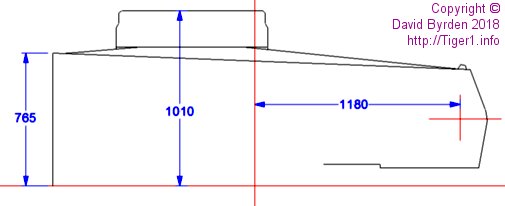
This side view shows one of these eight original Tiger (P) turrets, with the raised segment.
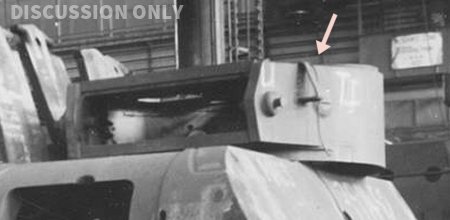
This is one of those eight turrets, photographed in 1945 at the factory. It has been stripped of most equipment, which presumably went into Tiger (H) production. Comparing it to the earlier photos, you will notice the brackets added on the outside front. They are mounts for the standard German smoke launcher system, which was designed for turrets with slanting sides. This feature was also added to the Tiger (H).
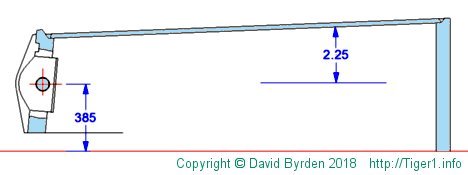
This is a sectional diagram showing the straight portion of the roof and the armour thickess. The roof is 25mm thick, keyed into the walls. Two thick crossbars form the front wall. Steel wedges fill the gaps at the sides of the front opening. The front wall is 100mm thick and slanted at 5 degrees.
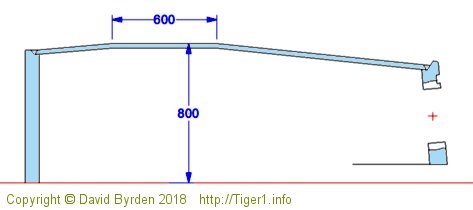
This sectional diagram runs through the raised segment of the roof. I have assumed that this segment was topped by a single bent plate.
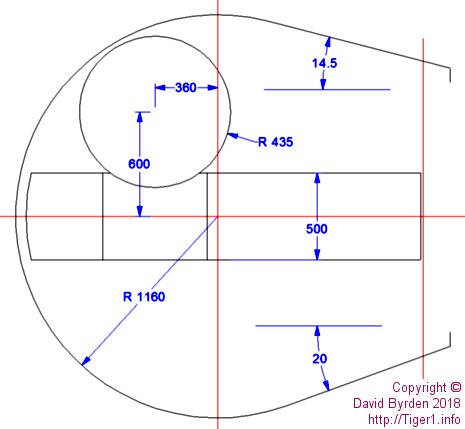
Some of these dimensions were reverse-engineered from photos. It's noteworthy, and in no doubt at all, that this turret's cupola is not in the same location as shown on the 1941 sketches. Presumably it had to be moved because of the raised segment. When the roof was redesigned to be higher, the cupola returned to its original place.
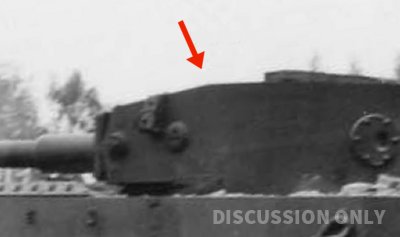
Two more Tiger (P) turrets were built toward the end of 1942, when the Tiger (H) was already in production. This photo shows one of them (lacking a cupola). One of these prototype tanks saw service in 1944.
The turret roof is now higher, as are the side walls. The roof plate now has a bend (indicated here), and its rear portion is horizontal. This same turret shape was used in the Tiger (H).
These last two Tiger (P) turrets had another change that cannot be seen in the photo. On the rear right side, instead of a pistol port, there was a large circular hatch. It was also added to Tiger (H) production in December, at about the 50th vehicle.
But the final two Tiger (P) turrets were not identical to Tiger (H) turrets. Their side vision ports were lower down, and their pistol ports had an opening on the right side instead of the left. Internally, I believe that Tiger (P) turrets had no rotating floor.
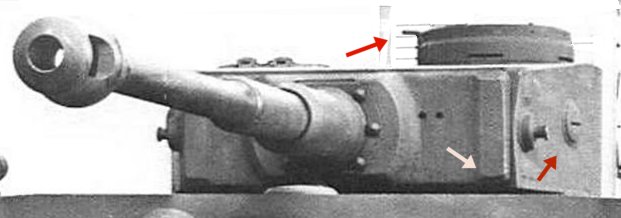
This is a Tiger (H) turret, as seen on the first prototype in 1942. As mentioned already, its vision ports are higher (indicated). The cupola has an L-shaped support to hold the hatch horizontal when open; this was soon replaced by an arm to hold it near vertical. The mantlet lacks a small notch in the lower left corner that was necessary in Tiger (P).
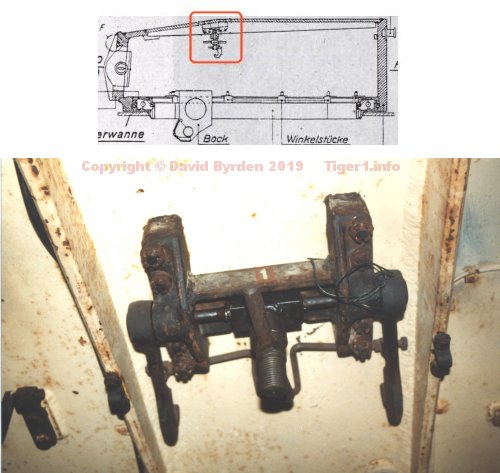
The height difference between the original roof, the raised segment and the production roof can be illustrated by examining the gun's travel lock. It is marked in this cross-section of an Early Tiger (H) turret.
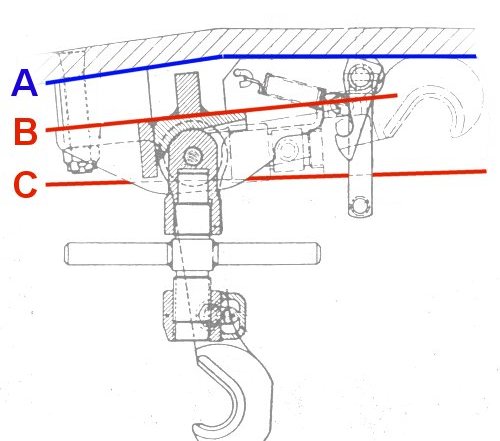
The "high" roof of the Tiger (H) is drawn here, and its underside is labelled [A]. But the travel lock was designed for the raised segment of the interim Tiger (P) roof, so there are added spacers holding it in that exact position. Therefore the upper surface of the lock, at [B], is a ghost of the old Tiger (P) central segment.
The "high" roof has two struts whose lower edges, at [C], correspond precisely to the original "Type 100" flat roof. There's no obvious reason to shape the struts like this, but we can speculate that a draftsman, when altering the original roof drawings, saved himself some time. A line existed on the drawing to represent the old roof, and rather than painstakingly scratch it off or cross it out, he repurposed it to indicate the new struts.